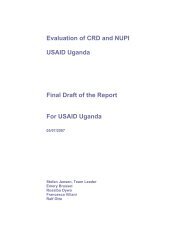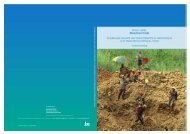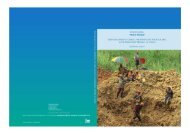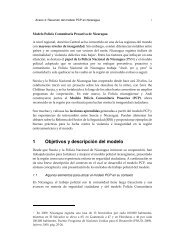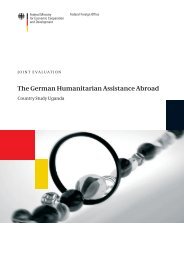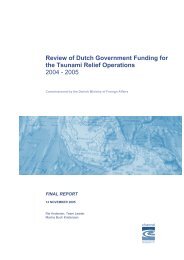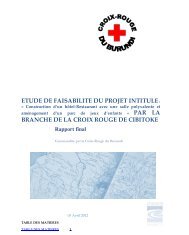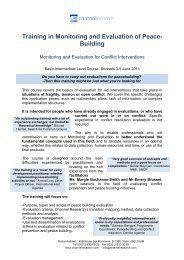A ripple in development? - Channel Research
A ripple in development? - Channel Research
A ripple in development? - Channel Research
Create successful ePaper yourself
Turn your PDF publications into a flip-book with our unique Google optimized e-Paper software.
The use of <strong>in</strong>formation plays a considerable and underestimated<br />
role <strong>in</strong> capacity build<strong>in</strong>g. Individuals met by our study found that mak<strong>in</strong>g<br />
and implement<strong>in</strong>g plans for their own recovery was difficult when<br />
they heard that they would receive a permanent shelter but were unsure<br />
about the type, location, or quality.<br />
This applies to the shap<strong>in</strong>g of l<strong>in</strong>kages between relief and <strong>development</strong>.<br />
Many of the thousands of <strong>in</strong>dividuals that donate to INGOs<br />
often want to “give a house” or “deliver a boat” to an affected family. If<br />
these thousands of <strong>in</strong>dividuals were to want to “build local capacity to<br />
provide safe houses”, the organisations would engage <strong>in</strong> that. There is<br />
no mechanism available with<strong>in</strong> the spectrum of LRRD to help this<br />
latent demand for build<strong>in</strong>g local capacity to be articulated, either as the<br />
rights of the victims or as a form of consumer demand from the beneficiaries<br />
of humanitarian aid and <strong>development</strong> <strong>in</strong>vestments.<br />
Several studies and <strong>in</strong>itiatives, <strong>in</strong>clud<strong>in</strong>g the Office of the Special<br />
Envoy for Tsunami Recovery’s NGO Impact Initiative, have emphasised<br />
the need for local capacity build<strong>in</strong>g <strong>in</strong> disaster recovery 95 . Several global<br />
efforts also give the mandate for support<strong>in</strong>g local capacity, <strong>in</strong>clud<strong>in</strong>g<br />
TRIAMS’ emphasis on evidence of capacity for recovery, and the Good<br />
Humanitarian Donorship Initiative’s call for donors to “strengthen the<br />
capacity of affected countries and local communities” 96 to prepare for an<br />
manage disasters. Additionally, the World Bank’s evaluations of its disaster<br />
recovery support also call for support to local <strong>in</strong>stitutions for ensur<strong>in</strong>g<br />
susta<strong>in</strong>able recovery by <strong>in</strong>creas<strong>in</strong>g the organisation capacity to respond<br />
quickly to disasters 97 . Public recognition and agreement on capacity<br />
<strong>development</strong> as a priority is one step forward but far from sufficient.<br />
6.5 Conclusion<br />
The issue of capacity <strong>development</strong> is affected by a lack of widely shared<br />
understand<strong>in</strong>g 98 . Yet gett<strong>in</strong>g capacity <strong>development</strong> right is essential:<br />
regardless of fund<strong>in</strong>g levels, relief, rehabilitation and <strong>development</strong><br />
efforts depend on capacities, particularly at the local level, for handover<br />
between <strong>in</strong>itiatives.<br />
The tsunami responses have <strong>in</strong>itiated a wide and diverse range of<br />
capacity build<strong>in</strong>g efforts. These have come from a wide range of agencies<br />
and communities. However little has been done to operationalise<br />
these concepts <strong>in</strong>to a know-how that would allow for a proper track<strong>in</strong>g<br />
of the progress achieved, and <strong>in</strong>itiatives tend to conceive of capacity as<br />
someth<strong>in</strong>g external, that could even be conceived of as an asset to be<br />
rented for specific tasks. The personnel management aspects of capacity<br />
are completely overlooked.<br />
95<br />
For more see: American Red Cross et al. (2006)<br />
96<br />
Pr<strong>in</strong>ciple #8. From GHD (2003)<br />
97<br />
World Bank/IEG (2008)<br />
98<br />
OECD/DAC (2006)<br />
105




